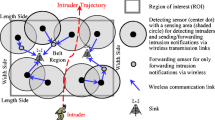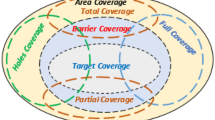Abstract
Barrier coverage in wireless sensor networks has been used in many applications such as intrusion detection and border surveillance. Barrier coverage is used to monitor the network borders to prevent intruders from penetrating the network. In these applications, it is critical to find optimal number of sensor nodes to prolong the network lifetime. Also, increasing the network lifetime is one of the important challenges in these networks. Various algorithms have been proposed to extend the network lifetime while guaranteeing barrier coverage requirements. In this paper, we use the imperialist competitive algorithm (ICA) for selecting sensor nodes to do barrier coverage monitoring operations called ICABC. The main objective of this work is to improve the network lifetime in a deployed network. To investigate the performance of ICABC, several simulations were conducted and the results of the experiments show that the ICABC significantly improves the performance than other state-of-art methods.













Similar content being viewed by others
References
Yick J, Mukherjee B, Ghosal D (2008) Wireless sensor network survey. Comput Netw 52(12):2292–2330
Kumar S, Lai T-H, Posner ME, Sinha P (2010) Maximizing the lifetime of a barrier of wireless sensors. IEEE Trans Mob Comput 9(8):1161
Dudek D, Haas C, Kuntz A, Zitterbart M, Krüger D, Rothenpieler P, Pfisterer D, Fischer S (2009) A wireless sensor network for border surveillance. In: Proceedings of the 7th ACM Conference on Embedded Networked Sensor Systems, ser. SenSys ’09. New York, NY, USA: ACM, pp 303–304. [Online]. doi:10.1145/1644038.1644072
Mostafaei H (2015) Stochastic barrier coverage in wireless sensor networks based on distributed learning automata. Comput Commun 55:51–61. doi:10.1016/j.comcom.2014.10.003
He S, Gong X, Zhang J, Chen J, Sun Y (2014) Curve-based deployment for barrier coverage in wireless sensor networks. IEEE Trans Wirel Commun 13(2):724–735
Kim K.-S, Jin G.-W (2012) Maximizing the lifetime of a sensor network with barrier coverage. In: Cho H.-S, Kim T.-H, Mohammed S, Adeli H, Oh M.-k, Lee K.-W (eds) Green and smart technology with sensor applications. International Conferences, GST and SIA 2012, Jeju Island, Korea, November 28-December 2, 2012. Springer, pp 347–354. doi:10.1007/978-3-642-35251-5_49
Mostafaei H, Meybodi MR (2014) An energy efficient barrier coverage algorithm for wireless sensor networks. Wirel Pers Commun 77(3):2099–2115. doi:10.1007/s11277-014-1626-1
Chen A, Kumar S, Lai TH (2007) Designing localized algorithms for barrier coverage. In: ACM MobiCom’07. ACM, pp 63–74
Kumar S, Lai TH, Arora A (2005) Barrier coverage with wireless sensors. In: ACM MobiCom’05. ACM, pp 284–298
Tao D, Wu T-Y (2015) A survey on barrier coverage problem in directional sensor networks. IEEE Sens J 15(2):876–885
Wang Z, Liao J, Cao Q, Qi H, Wang Z (2014) Achieving k-barrier coverage in hybrid directional sensor networks. IEEE Trans Mob Comput 13(7):1443–1455
Zhang L, Tang J, Zhang W (2009) Strong barrier coverage with directional sensors. In: Global Telecommunications Conference, 2009. GLOBECOM 2009. IEEE, Nov 2009, pp 1–6
Han R, Zhang L, Yang W (2016) Maximizing strong barriers in lifetime-heterogeneous directional sensor network. In: Wireless Communication Systems (ISWCS), 2016 International Symposium on. IEEE, pp 80–85
Edmonds J, Karp RM (1972) Theoretical improvements in algorithmic efficiency for network flow problems. J ACM (JACM) 19(2):248–264
Du J, Wang K, Liu H, Guo D (2013) Maximizing the lifetime of-discrete barrier coverage using mobile sensors. IEEE Sens J 13(12):4690–4701
Jia J, Wu X, Chen J, Wang X (2014) An autonomous redeployment algorithm for line barrier coverage of mobile sensor networks. Int J Ad Hoc Ubiquitous Comput 16(1):58–69
Watfa MK, Commuri S (2009) Self organization of sensor networks for energy-efficient border coverage. J Commun Netw 11(1):57–71
Wang Z, Chen H, Cao Q, Qi H, Wang Z, (2014) Fault tolerant barrier coverage for wireless sensor networks. In: INFOCOM, 2014 Proceedings IEEE, April 2014, pp 1869–1877
Lau BC, Ma EW, Chow TW (2014) Probabilistic fault detector for wireless sensor network. Expert Syst Appl 41(8):3703–3711
Panda M, Khilar P (2015) Distributed self fault diagnosis algorithm for large scale wireless sensor networks using modified three sigma edit test. Ad Hoc Netw 25(Part A):170–184
Huang RM, Qiu XS, Ye LL (2010) Probability-based fault detection in wireless sensor networks. In: Network and Service Management (CNSM), 2010 International Conference on, Oct 2010, pp 218–221
Mostafaei H, Montieri A, Persico V, Pescapé A (2017) A sleep scheduling approach based on learning automata for wsn partial coverage. J Netw Comput Appl 80:67–78. doi:10.1016/j.jnca.2016.12.022
McGarry S, Knight C (2012) Development and successful application of a tree movement energy harvesting device, to power a wireless sensor node. Sensors 12(9):12110–12125
Mostafaei H, Shojafar M (2015) A new meta-heuristic algorithm for maximizing lifetime of wireless sensor networks. Wirel Pers Commun 82(2):723–742. doi:10.1007/s11277-014-2249-2
Pooranian Z, Shojafar M, Javadi B, Abraham A (2014) Using imperialist competition algorithm for independent task scheduling in grid computing. J Intell Fuzzy Syst 27(1):187–199
Atashpaz-Gargari E, Lucas C (2007) Imperialist competitive algorithm: an algorithm for optimization inspired by imperialistic competition. In: Evolutionary Computation, 2007. CEC 2007. IEEE Congress on, Sept 2007, pp 4661–4667
“Wireless Sensor Networks Simulator,” http://www.djstein.com/Projects/Files/Wireless%20Sensor%20Network%20Simulator%20v1.1.zip, Jan 2016
Author information
Authors and Affiliations
Corresponding author
Rights and permissions
About this article
Cite this article
Mostafaei, H., Shojafar, M., Zaher, B. et al. Barrier coverage of WSNs with the imperialist competitive algorithm. J Supercomput 73, 4957–4980 (2017). https://doi.org/10.1007/s11227-017-2067-x
Published:
Issue Date:
DOI: https://doi.org/10.1007/s11227-017-2067-x




